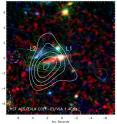Wild 'teenage'-galaxies booming with star births
Scientists from the Niels Bohr Institute have been studying distant galaxies, which are among the most active star-forming galaxies in the Universe. They form around 1,000 new stars a year – a 1,000 times more than our own galaxy, the Milky Way. The findings have been published in Monthly Notices of the Royal Astronomical Society. "The galaxies are located in the far distant Universe – when the universe was 3 billion years old (equivalent to only 20 percent of its current age). It is a period of the Universe when the galaxies were very active, almost teenager-like and out of control", describes Thomas R. Greve, Associate professor in astrophysics at Dark Cosmology Centre, Niels Bohr Institute at the University of Copenhagen.
Together with researchers from the Royal Observatory, Edinburgh and Durham University in England, he has studied the distant galaxies using the Expanded Very Large Array, which is an astronomical observatory in New Mexico, USA. The observatory consists of 27 parabolic antennas, each of which have a diameter of 25 meters and can measure radio waves from distant objects. Data from each antenna is combined electronically so that the final measurements have an angular resolution equivalent to a single antenna with a diameter of 36 km and a sensitivity equal to that of a single antenna with a diameter of 130 meters.
"We have measured the CO levels, that is to say carbon monoxide, which is one of the most common molecules in the universe, after the hydrogen molecule, H2. Using the measurements we have calculated how much gas there is in the galaxy and it turns out there are extremely large amounts of gas in these galaxies ", explains Thomas R. Greve.
Raw material for new stars
Gas is the raw material used in the Universe to form stars. In the galaxies the gas collects in large clouds, which become denser and denser as a result of their own gravitational pull. Eventually, the gas becomes so dense that it collapses into a ball of glowing gas, which forms a new star – the cloud almost 'explodes' in a cosmic firework display of new stars.
"What is new about our observations is that we have looked at the amount of cold, diffuse gas that is not yet actively star-forming, and what we can determine is that there is more than twice as much gas than previously thought. This means that there is an enormous amount of raw material, which can condense and form new stars ", explains Thomas R. Greve.
The measurements of the morphology of the gas also suggest that these galaxies are not only bigger than we thought, but also very irregular in their shape. It is only much later (several hundred billion years) in their development, after they have undergone their intense star formation that they become the mature, regular, elliptical shaped galaxies that we see in our Universe today.
Source: University of Copenhagen
Articles on the same topic
- Growing galaxies gentlyWed, 13 Oct 2010, 17:36:38 UTC
Other sources
- News galaxy growth method describedfrom UPIFri, 15 Oct 2010, 1:00:23 UTC
- Galaxy growth spurts explained: Young galaxies can grow by sucking in cool gasfrom Science DailyWed, 13 Oct 2010, 18:31:34 UTC
- Ancient Galaxies Really Sucked (Gas, That Is)from Space.comWed, 13 Oct 2010, 17:31:37 UTC
- Growing galaxies gentlyfrom PhysorgWed, 13 Oct 2010, 17:31:21 UTC
- ScienceShot: Young Galaxies Made Stars From Scratchfrom Science NOWWed, 13 Oct 2010, 17:30:27 UTC
- Wild 'teenage' galaxies booming with star birthsfrom Science DailyWed, 13 Oct 2010, 2:40:41 UTC
- 'Teenage'-galaxies booming with star birthsfrom PhysorgTue, 12 Oct 2010, 14:02:42 UTC
- The Universe likes to form galaxies similar to the Milky Wayfrom Science DailyMon, 11 Oct 2010, 15:30:33 UTC
- Brightest galaxies tend to cluster in busiest parts of universe, study findsfrom Science DailyMon, 11 Oct 2010, 3:31:39 UTC
